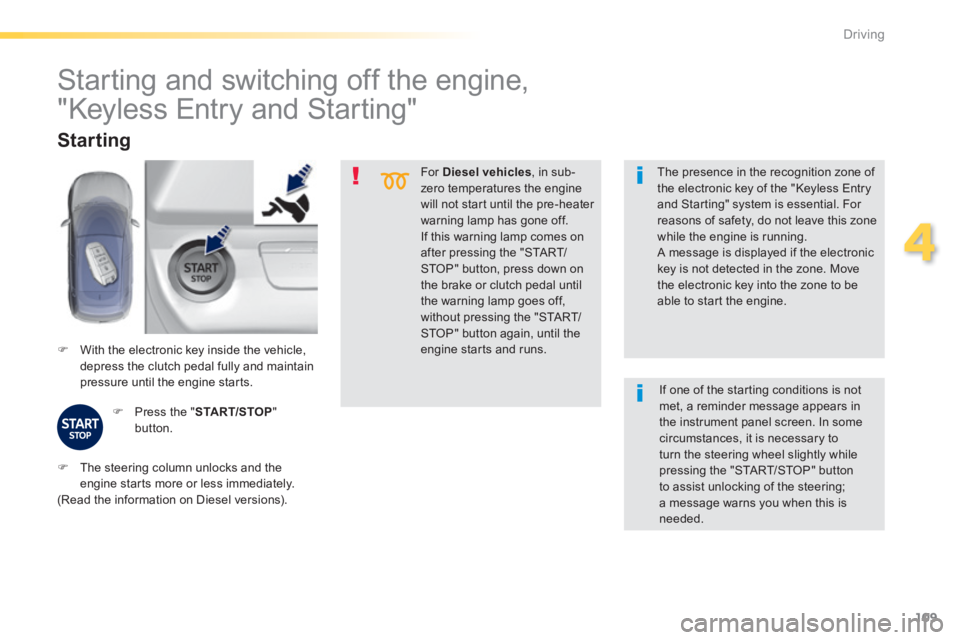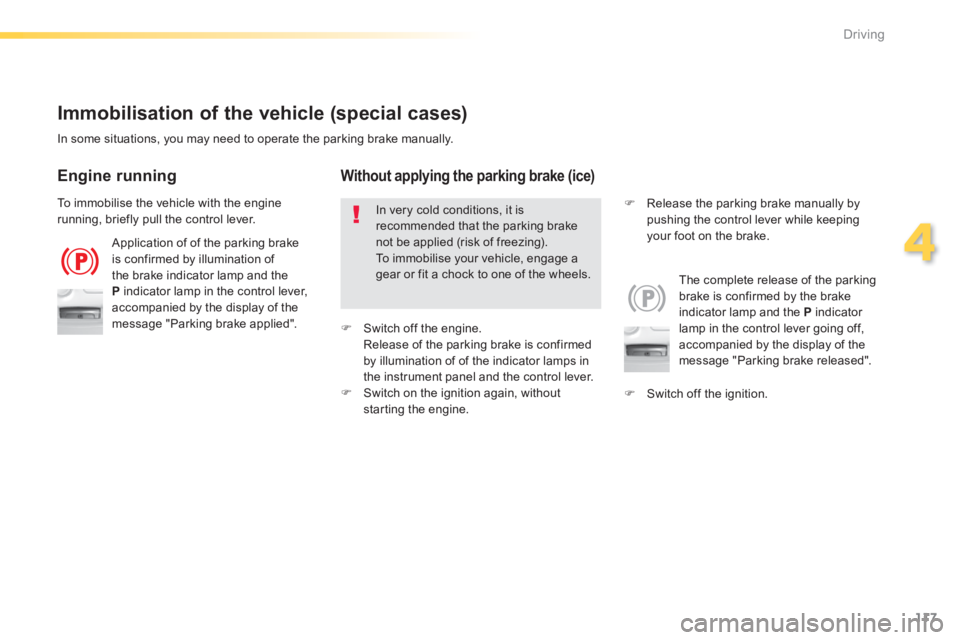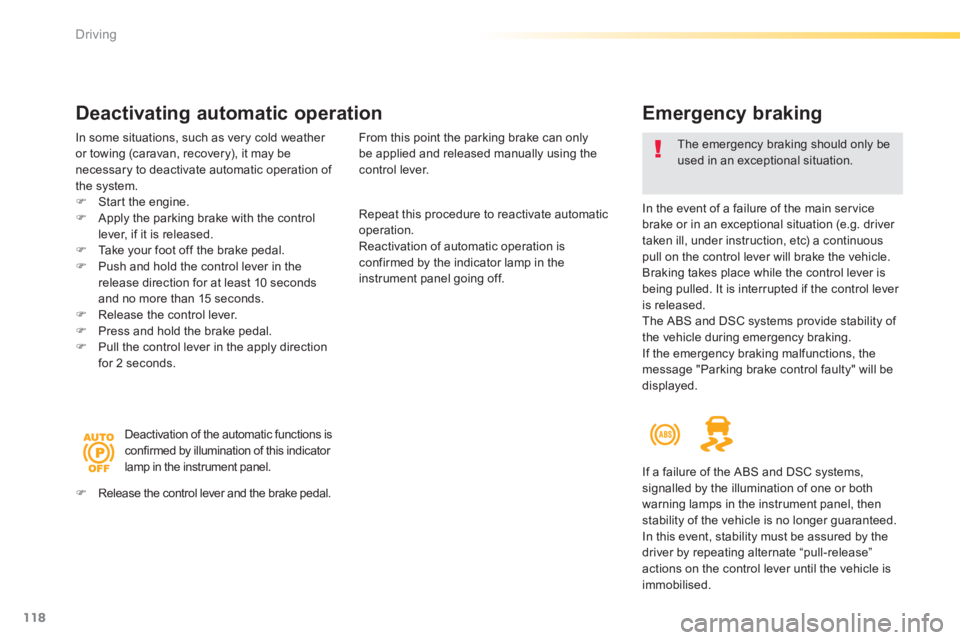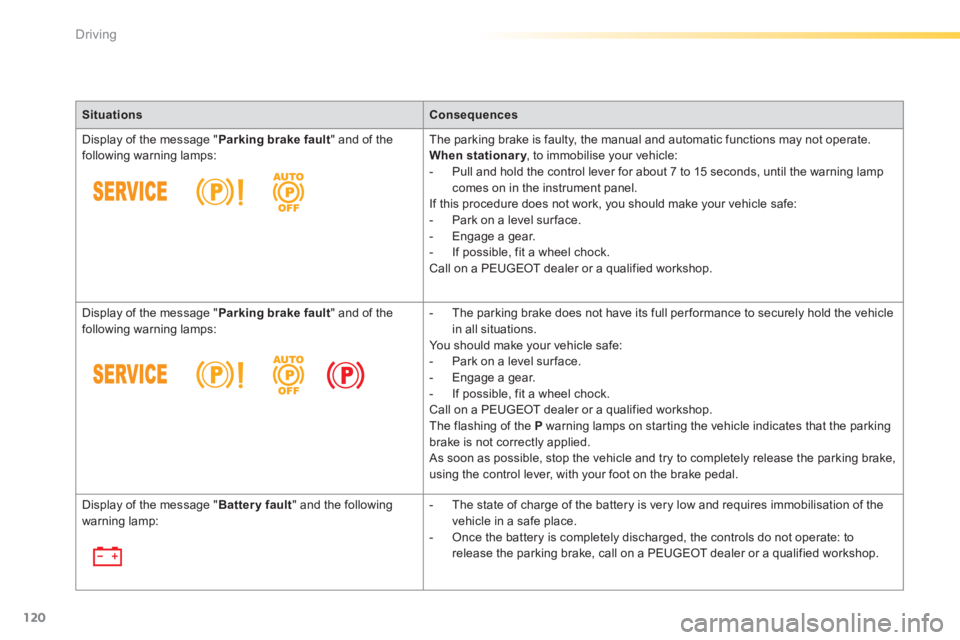2014 Peugeot 308 display
[x] Cancel search: displayPage 110 of 400

108
Driving
Starting-switching off the engine, remote control
Put the gear lever into neutral.
A heavy object (key fob...), attached to the key and weighing down on its shaft in the ignition switch, could cause a malfunction.
Key left in the "Ignition on" position
On opening the driver's door, an alert message is displayed, accompanied by an audible signal, to remind you that the key is still in the ignition switch at position 1 (Stop) .
If the key has been left in the ignition switch at position 2 (Ignition on) , the ignition will be switched off automatically after one hour. To switch the ignition back on, turn the key to position 1 (Stop) , then back to position 2 (Ignition on) .
Ignition switch
1. Stop position. 2. Ignition on position. 3. Starting position.
Starting using the key
Insert the key in the ignition switch. The system recognises the starting code. Turn the key fully towards the dashboard to position 3 (Starting) .
When the engine starts, release the key.
Immobilise the vehicle. Turn the key fully towards you to position 1 (Stop) . Remove the key from the ignition switch.
Switching off using the key
Switching off the engine leads to a loss of braking assistance.
Page 111 of 400

109
4
Driving
For Diesel vehicles , in sub-zero temperatures the engine will not start until the pre-heater warning lamp has gone off.
If this warning lamp comes on after pressing the "START/STOP" button, press down on the brake or clutch pedal until the warning lamp goes off, without pressing the "START/STOP" button again, until the engine starts and runs. With the electronic key inside the vehicle, depress the clutch pedal fully and maintain pressure until the engine starts.
Starting
Press the " START/STOP " button.
The presence in the recognition zone of the electronic key of the "Keyless Entry and Starting" system is essential. For reasons of safety, do not leave this zone
while the engine is running. A message is displayed if the electronic key is not detected in the zone. Move the electronic key into the zone to be able to start the engine.
Starting and switching off the engine,
"Keyless Entry and Starting"
The steering column unlocks and the engine starts more or less immediately. (Read the information on Diesel versions).
If one of the starting conditions is not met, a reminder message appears in the instrument panel screen. In some circumstances, it is necessary to turn the steering wheel slightly while pressing the "START/STOP" button to assist unlocking of the steering; a message warns you when this is needed.
Page 117 of 400

115
4
Driving
The area in front of the electric parking brake control is not intended for the storage of objects.
Automatic operation
Automatic release
The complete release of the parking brake is confirmed by the brake indicator lamp and the P indicator lamp in the control lever going off, accompanied by the display of the message "Parking brake released".
When stationary with the engine running, do not depress the accelerator pedal unnecessarily, you risk releasing the parking brake.
Automatic application
Application of of the parking brake is confirmed by illumination of the brake indicator lamp and the P indicator lamp in the control lever, accompanied by the display of the message "Parking brake applied".
With the engine stalled or in STOP mode of Stop & Start, automatic application does not take place.
With automatic operation, you can manually apply or release the parking brake using the control lever.
Ensure first that the engine is running and the driver's door is properly closed. The electric parking brake releases automatically and progressively when you
press the accelerator: Fully depress the clutch pedal, engage 1 st or reverse gear; press the accelerator pedal and let up the clutch pedal.
With the vehicle stationary, the parking brake is automatically applied when the ignition is switched off . switched off . switched off
Page 118 of 400

116
Driving
Label on door panel
Before leaving the vehicle, check that parking brake is applied: the indicator lamps in the instrument panel and the control lever must be on fixed, not flashing. If the parking brake is not applied, there is an audible signal and a message is displayed on opening the driver's door.
Manual operation
Application of of the parking brake is confirmed by illumination of the brake indicator lamp and the P indicator lamp in the control lever, accompanied by the display of the message "Parking brake applied".
Manual release
If you push the control lever without pressing the brake pedal, the parking brake will not be released and a
message is displayed.
With the vehicle stationary: briefly pull the control lever.
Confirmation of the instruction is signaled by flashing of the indicator lamp in the control l eve r.
With the ignition on or the engine running, to release the parking brake: press the brake pedal, briefly push the control lever. The complete release of the parking brake is confirmed by the brake indicator lamp and the P indicator lamp in the control lever going off, accompanied by the display of the message "Parking brake released" and an audible signal until the doors are closed.
Manual application
Page 119 of 400

117
4
Driving
Immobilisation of the vehicle (special cases)
Application of of the parking brake is confirmed by illumination of the brake indicator lamp and the P indicator lamp in the control lever, accompanied by the display of the message "Parking brake applied".
The complete release of the parking brake is confirmed by the brake indicator lamp and the P indicator lamp in the control lever going off, accompanied by the display of the message "Parking brake released".
In some situations, you may need to operate the parking brake manually.
Engine running
In very cold conditions, it is
recommended that the parking brake not be applied (risk of freezing). To immobilise your vehicle, engage a gear or fit a chock to one of the wheels.
Without applying the parking brake (ice)
Switch off the ignition.
Release the parking brake manually by pushing the control lever while keeping your foot on the brake.
To immobilise the vehicle with the engine running, briefly pull the control lever.
Switch off the engine. Release of the parking brake is confirmed by illumination of of the indicator lamps in the instrument panel and the control lever. Switch on the ignition again, without starting the engine.
Page 120 of 400

118
Driving
Emergency braking
In the event of a failure of the main service brake or in an exceptional situation (e.g. driver taken ill, under instruction, etc) a continuous pull on the control lever will brake the vehicle. Braking takes place while the control lever is being pulled. It is interrupted if the control lever is released. The ABS and DSC systems provide stability of the vehicle during emergency braking. If the emergency braking malfunctions, the message "Parking brake control faulty" will be displayed.
The emergency braking should only be used in an exceptional situation.
Repeat this procedure to reactivate automatic operation. Reactivation of automatic operation is confirmed by the indicator lamp in the instrument panel going off.
Deactivating automatic operation
In some situations, such as very cold weather or towing (caravan, recovery), it may be necessary to deactivate automatic operation of the system. Start the engine. Apply the parking brake with the control
lever, if it is released. Take your foot off the brake pedal. Push and hold the control lever in the release direction for at least 10 seconds and no more than 15 seconds. Release the control lever. Press and hold the brake pedal. Pull the control lever in the apply direction for 2 seconds.
Deactivation of the automatic functions is confirmed by illumination of this indicator lamp in the instrument panel.
Release the control lever and the brake pedal.
From this point the parking brake can only be applied and released manually using the control lever.
If a failure of the ABS and DSC systems, signalled by the illumination of one or both warning lamps in the instrument panel, then stability of the vehicle is no longer guaranteed. In this event, stability must be assured by the driver by repeating alternate “pull-release” actions on the control lever until the vehicle is
immobilised.
Page 121 of 400

119
4
Driving
Operating faults
The various alert situations are described in the table below. In the event of a fault with the electric parking brake it is recommended that you contact a PEUGEOT dealer or a qualified workshop without delay.
SituationsConsequences
Display of the message " Parking brake fault " and the following warning lamps: - Automatic release is not available. - If you attempt an automatic release, a help message is displayed on acceleration when the parking brake is applied, prompting you to use manual release.
Display of the message " Parking brake fault " and of the following warning lamps: - Back-up braking does not have full power. - If automatic release is not available, a help message is displayed on acceleration when the parking brake is applied, prompting you to use manual release.
Display of the message " Parking brake fault " and of the following warning lamps: - Automatic application is not available: use the control lever. - The electric parking brake can only be used manually. - If automatic release is also not available, a help message is displayed on acceleration when the parking brake is applied, prompting you to use manual release.
Display of the message " Parking brake fault " and of the following warning lamps: - If manual application and release do not work, the control lever is faulty. - The automatic functions must be used in all circumstances: they are automatically reactivated in the event of failure of the control lever. - You can no longer immobilise the vehicle with the engine running.
Page 122 of 400

120
Driving
SituationsConsequences
Display of the message " Parking brake fault " and of the following warning lamps: The parking brake is faulty, the manual and automatic functions may not operate. When stationary , to immobilise your vehicle: When stationary , to immobilise your vehicle: When stationary - Pull and hold the control lever for about 7 to 15 seconds, until the warning lamp comes on in the instrument panel. If this procedure does not work, you should make your vehicle safe: - Park on a level sur face. - Engage a gear. - If possible, fit a wheel chock. Call on a PEUGEOT dealer or a qualified workshop.
Display of the message " Parking brake fault " and of the following warning lamps: - The parking brake does not have its full per formance to securely hold the vehicle in all situations. You should make your vehicle safe: - Park on a level sur face. - Engage a gear. - If possible, fit a wheel chock. Call on a PEUGEOT dealer or a qualified workshop. The flashing of the P warning lamps on starting the vehicle indicates that the parking brake is not correctly applied. As soon as possible, stop the vehicle and try to completely release the parking brake, using the control lever, with your foot on the brake pedal.
Display of the message " Battery fault " and the following warning lamp: - The state of charge of the battery is very low and requires immobilisation of the vehicle in a safe place.
- Once the battery is completely discharged, the controls do not operate: to release the parking brake, call on a PEUGEOT dealer or a qualified workshop.